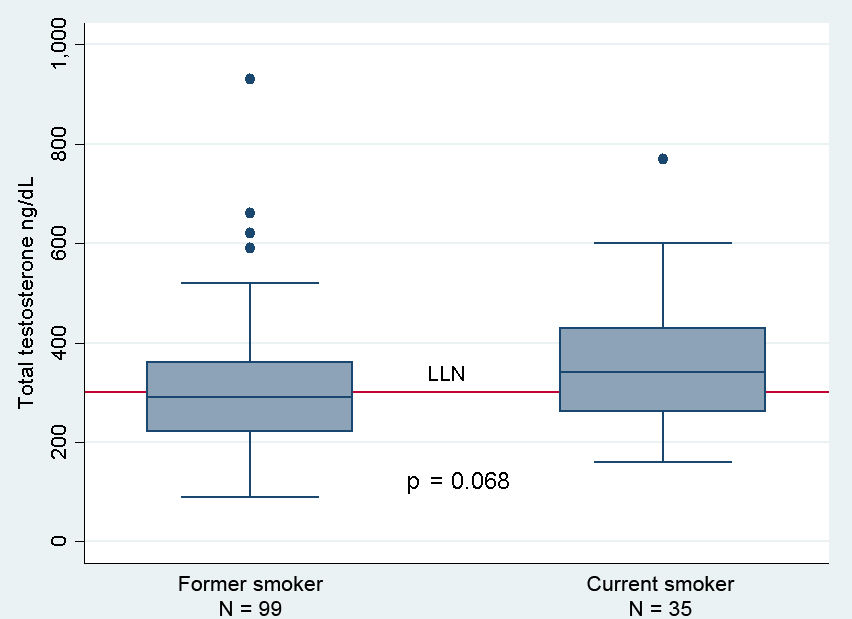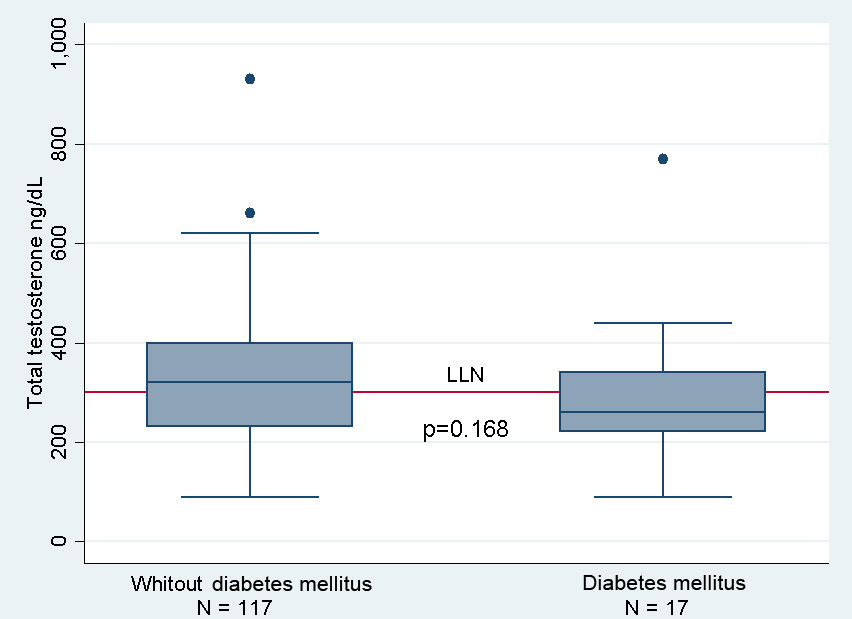Hypogonadism is a common finding of chronic obstructive pulmonary disease (COPD). However, the prevalence of hypogonadism in COPD varies among studies. The aim of this study was to determine and compare the prevalence of hypogonadism in men with and without COPD.
MethodsWe conducted a cross-sectional study with 134 patients with stable COPD and 70 age-matched men with non-COPD. Hypogonadism was defined by the presence of symptoms according to the Androgen Deficiency in Aging Males questionnaire, along with total testosterone deficiency (<300ng/dL).
ResultsPatients had a mean age of 68 years (SD, 6), a body mass index of 28kg/m2 (SD, 6), and 17% were current smokers. The prevalence of hypogonadism was 41.8% in COPD men (N=56, 95%CI, 33–51) and 10.0% in non-COPD men (N=7, 95%CI, 4–20), with a prevalence ratio of 4.2 (95%CI, 2.0–8.7, p<0.001). The prevalence of low total testosterone concentrations (<300ng/dL) were significantly higher in COPD patients vs the control group (47.0% vs 15.7%, p=<0.001). In the COPD group, 89.3% of patients had hypogonadotropic hypogonadism and 10.7%, hypergonadotropic hypogonadism. The prevalence of hypogonadism was higher in severe vs non-severe COPD patients (55.8% vs 35.2%; p=0.024).
ConclusionsThe prevalence of hypogonadism was high and greater in COPD vs non-COPD men. This study suggests that COPD patients should be screened for hypogonadism.
El hipogonadismo es frecuente en pacientes con enfermedad pulmonar obstructiva crónica (EPOC). Sin embargo, la prevalencia de hipogonadismo varía entre estudios. El objetivo del estudio fue determinar y comparar la prevalencia de hipogonadismo en hombres con y sin EPOC.
MétodosSe realizó un estudio de corte transversal que incluyó a 134 pacientes con EPOC estable y 70 hombres sin EPOC pareados por edad. Se definió el hipogonadismo por la presencia de síntomas según el cuestionario de Androgen Deficiency in Aging Males y una deficiencia de testosterona total (<300ng/dL).
ResultadosLos pacientes tenían una edad media de 68 años (DE 6), un índice de masa corporal de 28kg/m2 (DE 6) y el 17% eran fumadores. La prevalencia de hipogonadismo fue del 41,8% en hombres con EPOC (N=56, IC 95% 33-51) y del 10,0% en hombres sin EPOC (N=7, IC 95% 4-20), con una razón de prevalencia de 4,2 (IC 95% 2,0-8,7, p<0,001). La prevalencia de concentraciones bajas de testosterona total (<300ng/dL) fue significativamente mayor en los pacientes con EPOC que en el grupo de control (47,0% frente a 15,7%, p=<0,001). En el grupo de pacientes con EPOC, el 89,3% presento un hipogonadismo hipogonadotropo y el 10.7% un hipogonadismo hipergonadotropo. La prevalencia de hipogonadismo fue mayor en pacientes con EPOC grave que en los no graves (55,8% versus 35,2%, p=0,024).
ConclusionesLa prevalencia de hipogonadismo fue alta y mayor en hombres con EPOC que en hombres sin EPOC. Este estudio sugiere que los pacientes con EPOC deben ser evaluados para detectar hipogonadismo.














